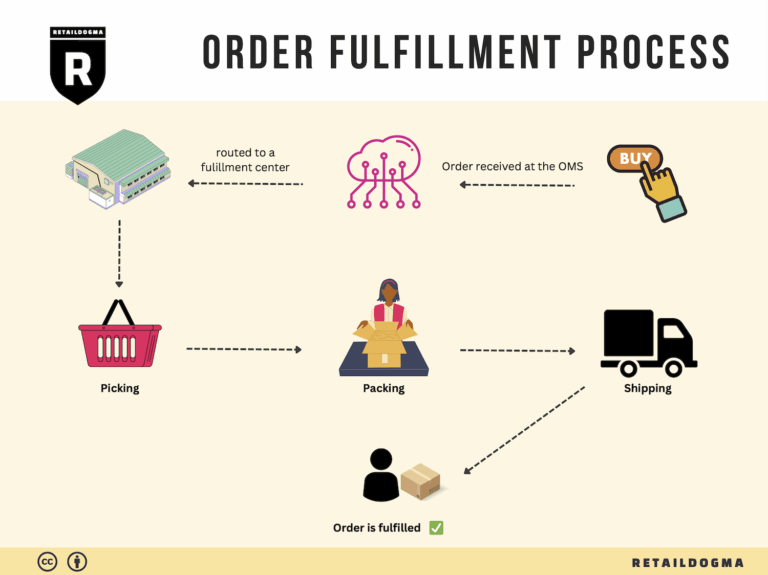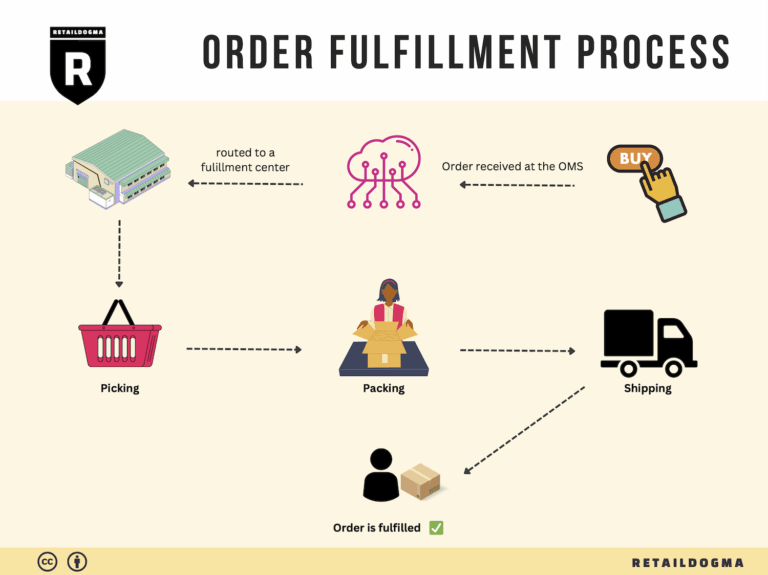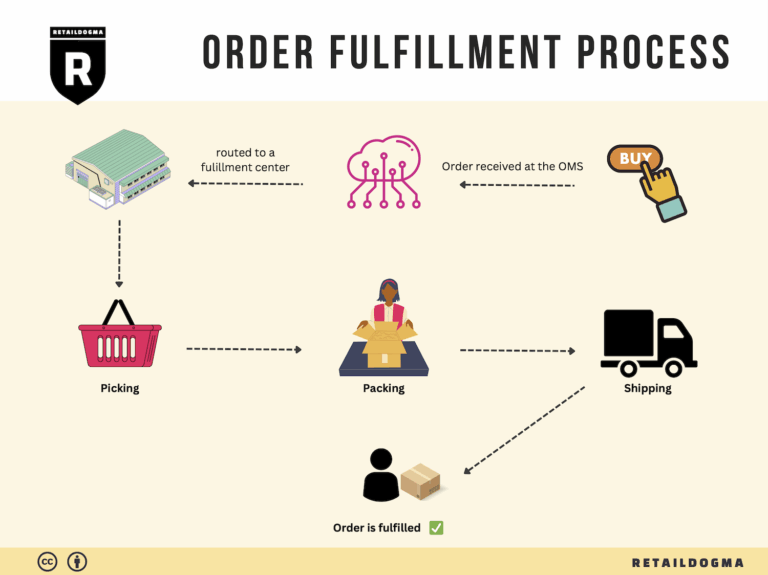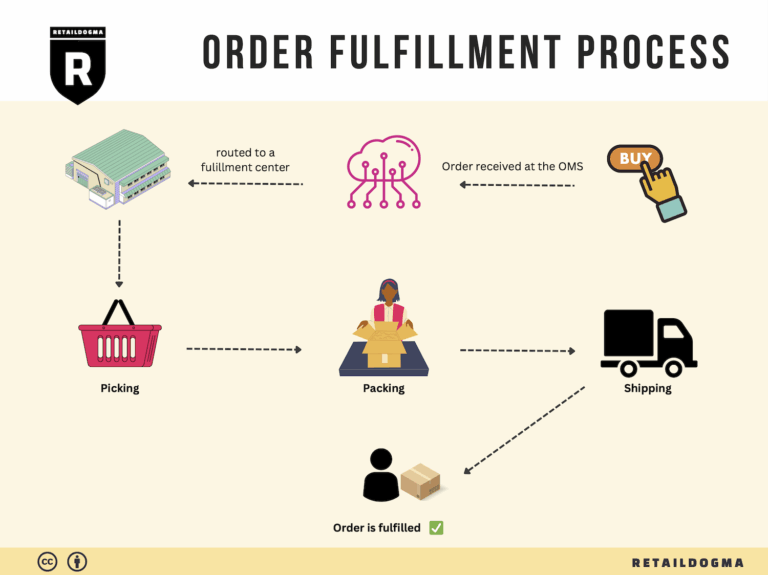Ecommerce Fulfillment Services: The Ultimate Guide (2025)
What is E-commerce Fulfillment? An Introduction for Growing Businesses
Understanding E-commerce Fulfillment: The Key to Scaling Your Business
As your online business begins to grow, the excitement of increasing sales can quickly turn into the stress of managing packing and shipping orders. Many entrepreneurs find themselves overwhelmed by the logistics involved in delivering products to customers efficiently and effectively. This is where e-commerce fulfillment comes into play—a crucial aspect of your business that can either enhance customer satisfaction or hinder growth.
E-commerce fulfillment is simply the process of getting a product from your warehouse or fulfillment center to your customer’s doorstep. This process encompasses various stages, including inventory management, order processing, picking and packing, shipping, and returns handling. For businesses looking to scale, understanding fulfillment options is essential to streamline operations and maintain a competitive edge.
In this guide, we will explore the different fulfillment models available to online businesses, such as Third-Party Logistics (3PL) and Fulfillment by Amazon (FBA). Each model has its advantages and disadvantages, and we will help you understand which might be the best fit for your specific needs.
We will also delve into the core services that fulfillment providers typically offer, including storage, order management, shipping solutions, and customer service. Knowing these services will empower you to evaluate potential partners effectively.
Choosing the right fulfillment partner is critical to your success. We will outline key factors to consider when selecting a fulfillment provider, such as their technology capabilities, location, scalability, and customer support. These elements can significantly impact your operational efficiency and customer experience.
Lastly, we will discuss pricing models for fulfillment services, helping you understand the costs involved and how they can align with your budget and business goals.

The goal of this guide is to empower you, the business owner, to make informed decisions about your logistics strategy. By understanding the intricacies of e-commerce fulfillment, you can focus on what you do best—growing your business—while ensuring that your customers receive their orders promptly and accurately. Let’s dive into the world of e-commerce fulfillment and set the stage for your business’s success.
What You’ll Learn In This Guide
- What is E-commerce Fulfillment? An Introduction for Growing Businesses
- The Order Fulfillment Process: From ‘Buy’ Button to Customer’s Door
- Comparing Fulfillment Models: In-House vs. 3PL vs. Dropshipping
- A Deep Dive into Amazon FBA: Pros, Cons, and Who It’s For
- Core Services Offered by Fulfillment Centers
- How to Choose a Fulfillment Partner: A 6-Point Checklist
- Understanding Fulfillment Pricing: A Breakdown of Common Fees
- Frequently Asked Questions (FAQs) about Fulfillment
- Conclusion: Is Outsourcing Fulfillment the Right Move for Your Business?
- Important Disclaimer
The Order Fulfillment Process: From ‘Buy’ Button to Customer’s Door
1. Receiving Inventory
The order fulfillment process begins with receiving inventory. This step involves accepting products from suppliers and verifying that the items match what was ordered. Each product is checked against a purchase order to ensure accuracy in quantity and quality. Key terms associated with this step include SKU (Stock Keeping Unit), which is a unique identifier for each product, enabling efficient tracking and management.
This stage is crucial because it sets the foundation for the entire fulfillment process. Proper inventory management at this stage helps prevent stock discrepancies, reduces errors, and ensures that customers receive the products they ordered. Efficient receiving processes can also minimize storage costs and optimize warehouse space, which is essential for scaling operations.
2. Warehouse Storage
Once inventory is received, the next step is warehouse storage. Products are categorized and stored in designated locations within the warehouse based on their SKU. This organization is often facilitated by warehouse management systems (WMS), which help optimize space and improve retrieval efficiency.
Effective warehouse storage is vital for maintaining an orderly system that allows for quick access to products during the picking phase. Properly stored inventory minimizes the time spent searching for items, which directly impacts order fulfillment speed. Additionally, implementing a systematic storage strategy, such as FIFO (First In, First Out) or LIFO (Last In, First Out), can help manage perishable goods and ensure that older stock is sold first.
3. Order Picking
Order picking is the process of retrieving products from the warehouse to fulfill customer orders. This step typically involves generating a pick list, which outlines the items and quantities needed for each order. There are various picking methods, such as single order picking, batch picking, and zone picking, each suited to different operational needs.
The importance of order picking lies in its direct impact on fulfillment accuracy and speed. Errors in picking can lead to customer dissatisfaction and increased return rates. By utilizing technology such as handheld scanners or automated picking systems, businesses can enhance accuracy and efficiency. As e-commerce continues to grow, optimizing the picking process becomes essential for scaling operations and meeting customer expectations.
4. Order Packing
After products are picked, they move to the packing stage. This step involves carefully packing the items for shipment, which includes selecting appropriate packaging materials, labeling, and preparing shipping documents. Key terms here include packing slips, which accompany the order to provide essential information to the customer and the shipping carrier.
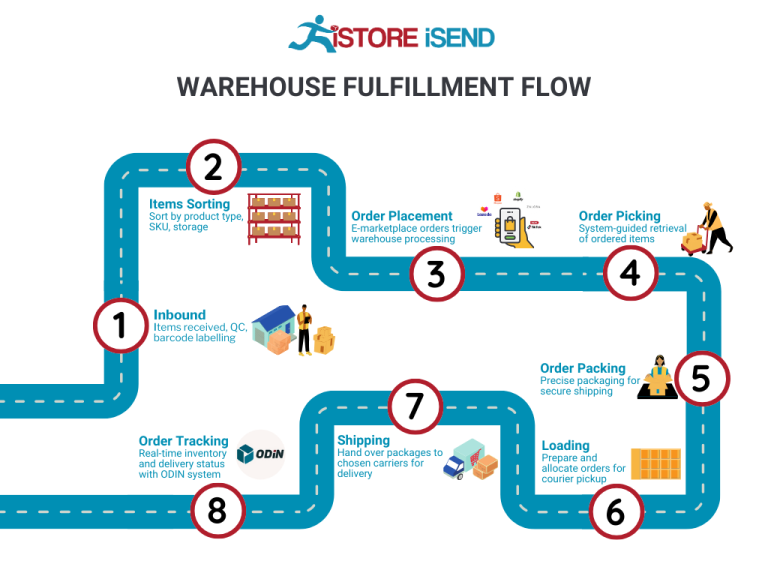
Order packing is critical for ensuring that products arrive at their destination in good condition. Effective packing minimizes damage during transit, reduces shipping costs through efficient use of space, and enhances the overall customer experience. Implementing packing best practices, such as using eco-friendly materials or offering customizable packaging options, can also differentiate your brand in a competitive market.
5. Shipping & Delivery
The final step in the order fulfillment process is shipping and delivery. This involves selecting a carrier, generating shipping labels, and arranging for the transportation of the order to the customer. Key terms associated with this stage include last-mile delivery, which refers to the final leg of the shipping journey where the package is delivered from a transportation hub to the customer’s doorstep.
Shipping and delivery are crucial for customer satisfaction and retention. Timely and accurate delivery can significantly influence a customer’s perception of your brand. To enhance efficiency, businesses can leverage technology such as real-time tracking systems, route optimization software, and automated notifications to keep customers informed throughout the delivery process. As e-commerce continues to evolve, optimizing shipping and delivery strategies will be essential for scaling operations and meeting customer demands.
By mastering these five steps—receiving inventory, warehouse storage, order picking, order packing, and shipping & delivery—e-commerce businesses can create a streamlined order fulfillment process that enhances efficiency, reduces costs, and ultimately drives customer satisfaction.
Comparing Fulfillment Models: In-House vs. 3PL vs. Dropshipping
Fulfillment Model Comparison
| Model | Who Handles Inventory | Best For (Business Stage) | Key Advantage | Key Disadvantage |
|---|---|---|---|---|
| In-House Fulfillment | Business owns and manages inventory | Established businesses with stable demand | Full control over inventory and processes | High operational costs and complexity |
| Third-Party Logistics (3PL) | 3PL provider manages inventory | Growing businesses looking to scale | Access to expertise and scalability | Less control over inventory and processes |
| Dropshipping | Supplier/manufacturer handles inventory | Startups or businesses testing new markets | Low upfront costs and no inventory risk | Lower margins and reliance on supplier performance |
In-House Fulfillment
In-house fulfillment involves a business managing its own inventory and logistics operations. This model is best suited for established companies that have a stable demand for their products, allowing them to streamline their operations and optimize their supply chain processes. One of the primary advantages of in-house fulfillment is the complete control it offers over inventory management, order processing, and shipping. Businesses can ensure that their brand standards are met, as they directly oversee every aspect of the fulfillment process. However, this level of control comes at a cost. Maintaining a warehouse, hiring staff, and managing logistics can lead to high operational costs and increased complexity. Moreover, businesses may struggle to scale operations quickly in response to market changes, which can hinder growth opportunities.
Third-Party Logistics (3PL)
Third-party logistics (3PL) involves outsourcing fulfillment operations to a specialized logistics provider. This model is ideal for growing businesses that want to scale without the burden of managing their own warehouses and logistics. 3PL providers offer a wealth of expertise and resources, including advanced technology, distribution networks, and industry knowledge that can help businesses optimize their supply chains. By leveraging a 3PL, companies can focus on their core competencies, such as product development and marketing, while the 3PL handles storage, packing, and shipping. The scalability of 3PL services allows businesses to respond rapidly to changes in demand. However, the key downside is the reduced control over inventory management and fulfillment processes. Businesses must rely on their 3PL partners to maintain the quality and efficiency of operations, which can lead to challenges if communication or service levels falter.
Dropshipping
Dropshipping is a fulfillment model where a business sells products without holding any inventory. Instead, when a customer places an order, the business purchases the item from a third-party supplier, who then ships it directly to the customer. This model is particularly appealing for startups or businesses testing new markets, as it requires minimal upfront investment and eliminates the risk associated with managing inventory. Since businesses do not need to invest in warehouses or stock, they can operate with lower overhead costs. However, dropshipping comes with its own set of challenges. Margins can be lower than other fulfillment models due to reliance on suppliers, and businesses have less control over product quality and shipping times. If suppliers fail to deliver on time or maintain product quality, it can negatively impact customer satisfaction and brand reputation. Additionally, businesses must navigate the complexities of supplier relationships and ensure that they are selecting reliable partners to maintain a smooth fulfillment process.
Conclusion
Choosing the right fulfillment model is crucial for e-commerce businesses looking to scale effectively. Each model presents unique advantages and challenges that must align with the company’s business goals, operational capacity, and market demands. By carefully assessing their needs and future growth potential, business owners can select the fulfillment strategy that best supports their vision and maximizes their operational efficiency.
A Deep Dive into Amazon FBA: Pros, Cons, and Who It’s For
Understanding Fulfillment by Amazon (FBA)
Fulfillment by Amazon (FBA) is a service offered by Amazon that allows sellers to store their products in Amazon’s fulfillment centers. Amazon then takes care of storage, packaging, and shipping of these products directly to customers. This service enables e-commerce businesses to leverage Amazon’s extensive logistics network, making it easier to reach a larger customer base without the burden of managing inventory and shipping logistics themselves.
When a customer places an order for a product fulfilled by FBA, Amazon handles the entire process—from picking the product from the warehouse to packaging it and shipping it out. Additionally, FBA allows sellers to benefit from Amazon’s customer service and returns handling, which can significantly improve customer satisfaction and trust.
How FBA Works
-
Set Up Your FBA Account: Sellers begin by creating an Amazon Seller account and enrolling in the FBA program. This involves choosing which products to fulfill through FBA and listing them on Amazon.
-
Ship Your Products to Amazon: Sellers need to prepare their products according to Amazon’s packaging requirements and ship them to Amazon’s fulfillment centers. Amazon provides guidelines on how to package and label products to ensure they meet their standards.
-
Storage and Fulfillment: Once the products arrive at Amazon’s warehouses, they are stored until sold. When an order is placed, Amazon picks, packs, and ships the product directly to the customer.
-
Customer Service and Returns: Amazon handles customer inquiries and returns for FBA products, which can save sellers considerable time and effort.
-
Payment: Sellers are paid by Amazon after the products are sold, minus Amazon’s fees for using the FBA service.
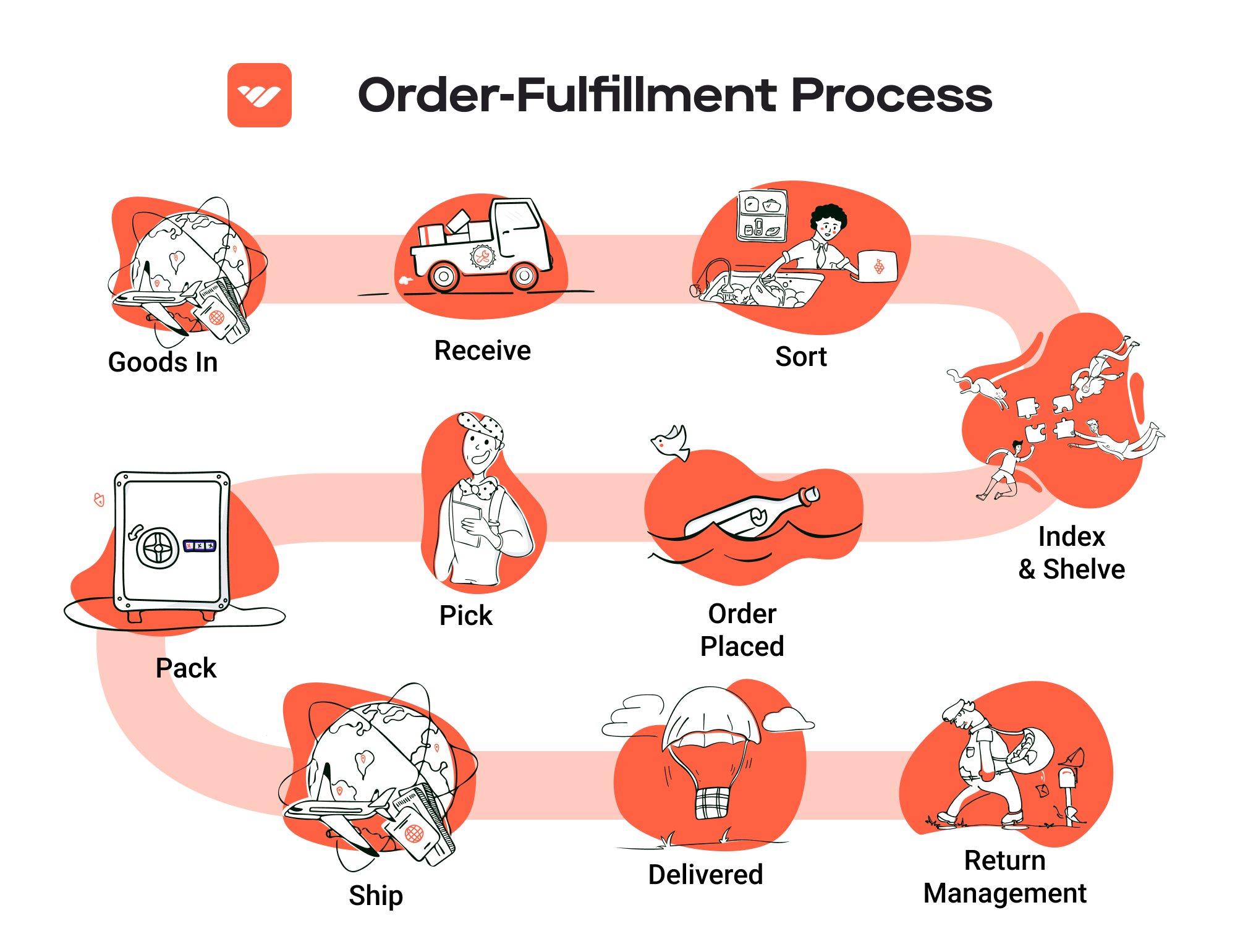
Pros of Using FBA
Prime Eligibility
One of the significant advantages of using FBA is that products become eligible for Amazon Prime, which is a considerable draw for customers. Prime members often prefer Prime-eligible products due to faster shipping options (usually two-day shipping), which can lead to increased sales for sellers.
Customer Trust
Products fulfilled by Amazon benefit from the trust associated with the Amazon brand. Customers are more likely to purchase items that are backed by Amazon’s customer service and returns policy. This trust can lead to higher conversion rates and repeat business.
Multi-Channel Fulfillment
FBA is not limited to sales on Amazon alone. Sellers can also use FBA to fulfill orders from their own websites or other e-commerce platforms, allowing them to manage inventory and fulfillment from a single source, thus streamlining operations.
Cons of Using FBA
High Fees
While FBA offers many benefits, it also comes with a variety of fees, including storage fees, fulfillment fees, and additional charges for long-term storage. These fees can add up quickly, especially for sellers with low-margin products or slow-moving inventory. It’s crucial for sellers to carefully calculate these costs to ensure profitability.
Strict Inventory Rules
Amazon has stringent rules regarding inventory management. Sellers must adhere to guidelines on inventory levels, labeling, and packaging. Failure to comply can result in additional fees or even removal of listings. This rigidity can be challenging for small businesses that may not have the resources to manage compliance effectively.
Commingling Risks
When using FBA, sellers’ products may be commingled with those of other sellers. This means that customers might receive a product from a different seller than the one they purchased from, which can lead to quality control issues and affect brand reputation. If a product is defective or of lower quality, it can harm the seller’s ratings and reviews.
Who is FBA Best For?
FBA is particularly well-suited for:
-
Small to Medium-Sized Businesses: Companies that want to scale quickly without the overhead of managing their own logistics can benefit greatly from FBA. It allows them to focus on product development and marketing while Amazon handles fulfillment.
-
Sellers with High Turnover Products: Businesses that sell products with a high turnover rate can take advantage of FBA’s efficient logistics to keep up with demand without incurring excessive storage fees.
-
Brands Looking to Increase Visibility: Sellers aiming to enhance their visibility on Amazon and attract Prime customers will find FBA advantageous as it opens up additional sales channels and promotional opportunities.
-
E-commerce Entrepreneurs Testing New Markets: For sellers looking to explore new markets or product lines without committing significant resources to logistics and inventory management, FBA offers a low-risk entry point.
In conclusion, FBA can be a powerful tool for e-commerce businesses looking to scale their operations, enhance customer satisfaction, and simplify fulfillment processes. However, it is essential for sellers to weigh the pros and cons carefully, considering their specific business models and financial situations, to determine if FBA aligns with their long-term goals.
Core Services Offered by Fulfillment Centers
Inventory Management & Warehousing
Effective inventory management and warehousing are foundational services provided by fulfillment centers. This service encompasses the strategic organization, storage, and oversight of inventory to ensure that products are readily available for order fulfillment while minimizing excess stock and associated carrying costs.
Fulfillment centers utilize sophisticated inventory management systems that employ real-time tracking, automated stock level alerts, and data analytics. This enables e-commerce businesses to maintain optimal inventory levels, preventing stockouts and overstock situations. By leveraging these systems, businesses can ensure that they meet customer demand without incurring unnecessary costs.
The benefits of robust inventory management include improved cash flow, better forecasting, and enhanced operational efficiency. With accurate inventory data, businesses can make informed decisions regarding purchasing, promotions, and seasonal sales strategies. Additionally, efficient warehousing practices reduce the time products spend in storage, leading to faster order processing and enhanced customer satisfaction.
Pick and Pack Services
Pick and pack services are critical components of the fulfillment process, involving the selection of ordered items from inventory (picking) and the preparation of those items for shipment (packing). Fulfillment centers employ systematic processes and often advanced technologies, such as barcode scanning and automated picking systems, to streamline this operation.
The efficiency of pick and pack services directly impacts delivery speed and accuracy, which are crucial for maintaining customer satisfaction in an increasingly competitive e-commerce landscape. By outsourcing these services to a fulfillment center, businesses can focus on their core operations—like marketing and customer engagement—while ensuring that orders are fulfilled accurately and promptly.
The primary benefits of effective pick and pack services include reduced lead times, increased order accuracy, and scalability. As e-commerce businesses grow, fulfillment centers can easily adjust their operations to accommodate fluctuating order volumes, ensuring that businesses can scale without the burden of additional labor or infrastructure investments.
Kitting and Assembly
Kitting and assembly services refer to the process of grouping individual items into ready-to-sell sets or kits, often tailored for specific customer needs or promotional offers. This service can include assembling products, packaging them together, and labeling them as a single unit.
For e-commerce businesses, kitting can enhance the shopping experience by providing customers with bundled products at a perceived value, often resulting in higher average order values. Moreover, kitting helps businesses manage inventory more effectively by reducing the number of individual stock-keeping units (SKUs) they need to track.
The advantages of kitting and assembly services include increased operational efficiency and the ability to offer unique product combinations that cater to specific customer preferences. This not only differentiates a business from competitors but also allows for targeted marketing campaigns that drive sales.
Returns Management (Reverse Logistics)
Returns management, or reverse logistics, is an essential service offered by fulfillment centers, focusing on handling product returns and exchanges efficiently. This process involves receiving returned items, inspecting them, restocking them if they are in sellable condition, or managing their disposal if necessary.
A robust returns management system is vital for e-commerce businesses, as customer expectations regarding return policies and processes have evolved significantly. Customers now anticipate a seamless and hassle-free return experience, which can influence their purchasing decisions. A well-managed returns process can enhance customer loyalty and retention by instilling confidence in the purchase process.
The benefits of effective returns management include improved customer satisfaction, reduced operational costs, and valuable insights into product performance and customer preferences. By analyzing return data, businesses can identify trends, address quality issues, and refine their product offerings, ultimately leading to better inventory management and increased sales.
In conclusion, fulfillment centers provide a suite of core services that are essential for e-commerce businesses looking to scale their operations. From inventory management and pick and pack services to kitting and returns management, these services not only streamline logistics but also enhance the overall customer experience. By partnering with a fulfillment center, businesses can focus on growth while ensuring that their logistics operations are efficient, accurate, and responsive to market demands.
How to Choose a Fulfillment Partner: A 6-Point Checklist
Location & Warehouse Network
Why It Matters:
The location of your fulfillment partner’s warehouses is crucial to your shipping efficiency and costs. A strategically placed warehouse network can significantly reduce delivery times and shipping expenses, directly impacting customer satisfaction.
Questions to Ask:
1. Where are your warehouses located, and how do these locations align with my customer base?
2. Do you have plans for expanding your warehouse network?
3. How do you handle regional shipping and logistics challenges?
Technology & Integrations
Why It Matters:
In today’s digital age, the technology stack of your fulfillment partner can either enhance or hinder your operations. Look for systems that integrate seamlessly with your e-commerce platform, inventory management tools, and customer relationship management (CRM) systems.
Questions to Ask:
1. What technology do you use for inventory management, order processing, and shipping?
2. How do you ensure data accuracy and real-time visibility of inventory levels?
3. Can your system integrate with my existing platforms (e.g., Shopify, WooCommerce, Amazon)?
Specializations (e.g., Cold Storage, Oversized Items)
Why It Matters:
Different businesses have unique needs based on their products. If you sell items requiring special handling, such as perishable goods or oversized items, your fulfillment partner should have the necessary capabilities and expertise.
Questions to Ask:
1. Do you offer specialized services such as cold storage, hazardous materials handling, or fulfillment for oversized items?
2. What processes do you have in place to ensure the integrity of sensitive products during storage and shipping?
3. Can you accommodate seasonal spikes in demand for specialized items?
Scalability & Capacity
Why It Matters:
As your business grows, your fulfillment needs will evolve. A partner that can scale with you—whether through additional storage space, resources, or capabilities—will help you maintain operational efficiency without disruption.
Questions to Ask:
1. How do you handle fluctuations in order volume, especially during peak seasons?
2. What is your current capacity, and how quickly can you scale up operations if my business grows?
3. Can you provide examples of how you’ve successfully supported other clients through periods of rapid growth?
Pricing and Contracts
Why It Matters:
Understanding the cost structure and contractual obligations is essential for budgeting and financial forecasting. Transparency in pricing will help you avoid unexpected costs that can eat into your margins.
Questions to Ask:
1. What are your pricing models (e.g., per order, monthly fees, storage fees)?
2. Are there any hidden fees I should be aware of (e.g., for returns, special handling)?
3. What is the length of the contract, and what are the terms for cancellation or modification?
Customer Support & Reviews
Why It Matters:
Reliable customer support can make a significant difference in your fulfillment experience. Efficient communication and quick problem resolution are vital in maintaining customer satisfaction and operational continuity.
Questions to Ask:
1. What level of customer support do you provide (e.g., dedicated account manager, 24/7 support)?
2. How do you handle issues such as order errors or shipping delays?
3. Can you provide references or case studies from current or past clients?
Conclusion
Choosing the right fulfillment partner is a critical decision that can impact your e-commerce business’s efficiency and customer satisfaction. By using this checklist, you can systematically evaluate potential partners based on key criteria that align with your business needs and growth strategies. Prioritize these elements in your discussions, and ensure you are making an informed decision that will set your business up for success in the competitive e-commerce landscape.
Understanding Fulfillment Pricing: A Breakdown of Common Fees
Initial Setup Fees
Initial setup fees are often incurred when establishing a new fulfillment account with a provider. These fees can vary widely depending on the complexity of your operations and the services required. Typically, they cover the costs associated with onboarding your business onto the fulfillment platform, including system integration, warehouse configuration, and initial training for your team.
To calculate initial setup fees, fulfillment centers will assess factors such as:
– The number of SKUs (Stock Keeping Units) you have and their storage requirements.
– The complexity of your inventory management systems.
– Any specific technology integrations you might need, such as API connections to your e-commerce platform.
It’s essential to inquire about all components of the setup process to avoid unexpected costs later.
Receiving Fees
Receiving fees are charged for the process of accepting and logging incoming inventory into the fulfillment center. This fee typically covers labor costs associated with unloading shipments, inspecting items, and updating inventory systems.
These fees can be calculated based on:
– The number of pallets or boxes received.
– The time it takes to process the incoming goods.
– Any special handling requirements, such as temperature-controlled items or fragile products.
Understanding the specifics of how receiving fees are structured can help you plan your inventory shipments more effectively, ensuring you choose the most economical shipping methods.
Storage Fees (per pallet/bin)
Storage fees are assessed based on the amount of space your inventory occupies in the fulfillment center. They are usually calculated on a monthly basis, either per pallet or per bin, depending on how the warehouse is organized.
Factors influencing storage fees include:
– The total volume of inventory stored.
– The duration of time items remain in storage.
– Seasonal fluctuations in storage needs, which may lead to increased rates during peak periods.
To optimize storage fees, it’s advisable to maintain an accurate inventory turnover rate. Regularly assess which items are slow-moving to reduce storage costs.
Pick & Pack Fees (per item/order)
Pick & pack fees apply to the process of selecting items from inventory and preparing them for shipment. This fee is typically charged on a per-item or per-order basis, depending on the fulfillment provider’s pricing model.
These fees can be influenced by:
– The complexity of the order (e.g., multiple SKUs vs. single SKU).
– The type of packaging required (standard boxes vs. custom packaging).
– The efficiency of your pick and pack processes, which can be improved through automation or streamlined operations.
Understanding how pick & pack fees are structured can help you manage your order fulfillment costs more effectively, especially as your order volumes increase.
Shipping Fees
Shipping fees are one of the most significant costs in the fulfillment process, covering the transportation of goods from the fulfillment center to your customers. These fees can vary based on multiple factors, including:
– The shipping carrier selected (e.g., USPS, FedEx, UPS).
– The destination of the shipment (domestic vs. international).
– The weight and dimensions of the package.
Some fulfillment centers offer discounted shipping rates through partnerships with carriers, which can significantly reduce your overall shipping costs. It’s crucial to understand how shipping fees are calculated and to explore options for optimizing these costs.
Tips for Getting an Accurate Quote
-
Provide Detailed Information: When requesting quotes, be specific about your inventory, order volumes, and expected shipping frequency. This will help fulfillment providers give you a more accurate estimate.
-
Ask About All Fees: Ensure you understand all potential charges, including hidden fees that may arise during busy seasons or due to special handling requirements.
-
Compare Providers: Don’t settle for the first quote you receive. Compare several fulfillment centers to find the best balance of service and cost.
-
Negotiate Terms: Many fulfillment centers are open to negotiation, especially if you anticipate high volumes. Don’t hesitate to discuss your needs and seek better rates or terms.
-
Consider Future Growth: Think about your long-term needs. Choose a fulfillment provider that can scale with your business to avoid the hassle of changing providers later.
By understanding these common fulfillment pricing models and following these tips, you can better navigate the complexities of fulfillment costs and make informed decisions that support your business’s growth.
Frequently Asked Questions (FAQs) about Fulfillment
1. What is fulfillment in e-commerce?
Fulfillment in e-commerce refers to the entire process of receiving, processing, and delivering orders to customers. This includes inventory management, order processing, packing, and shipping. Efficient fulfillment is critical for customer satisfaction and can significantly impact a business’s reputation and repeat sales.
2. What is the difference between a warehouse and a fulfillment center?
A warehouse is primarily used for storage, where goods are kept until they are needed. In contrast, a fulfillment center is a specialized type of warehouse that focuses on processing orders and shipping products directly to customers. Fulfillment centers often utilize advanced technology and logistics strategies to expedite order processing and delivery.
3. What is a 3PL (Third-Party Logistics)?
A 3PL is a company that provides outsourced logistics services, which can include transportation, warehousing, inventory management, and fulfillment. Partnering with a 3PL allows businesses to leverage the provider’s expertise and resources, enabling them to scale operations without the overhead costs associated with maintaining their own logistics infrastructure.
4. How much do fulfillment services cost?
The cost of fulfillment services can vary widely based on several factors, including order volume, the complexity of the service, storage needs, and shipping destinations. Typically, fulfillment costs include storage fees, order processing fees, and shipping charges. Businesses should evaluate multiple providers and consider not just price, but also service quality and technology capabilities.
5. What are micro-fulfillment centers?
Micro-fulfillment centers are small, automated warehouses located closer to customers, designed to expedite order fulfillment for e-commerce. They leverage advanced technologies such as robotics and automation to enhance picking and packing efficiency. This strategy helps retailers meet consumer demand for faster delivery times while minimizing shipping costs.
6. How can automation improve fulfillment efficiency?
Automation can significantly improve fulfillment efficiency by streamlining processes such as picking, packing, and inventory management. Technologies like robotics, conveyor systems, and inventory management software can reduce human error, speed up operations, and increase order accuracy, leading to better customer satisfaction and lower operational costs.
7. What role does technology play in fulfillment?
Technology plays a crucial role in modern fulfillment operations. It enables real-time inventory tracking, order processing automation, and data analytics for demand forecasting. Additionally, technologies such as blockchain and the Internet of Things (IoT) enhance transparency, traceability, and collaboration across the supply chain, ultimately leading to improved efficiency and customer service.
8. What is the impact of COVID-19 on e-commerce fulfillment?
The COVID-19 pandemic accelerated the shift towards online shopping, leading to a surge in e-commerce fulfillment needs. Retailers have had to adapt quickly by enhancing their logistics capabilities, investing in automation, and implementing contactless delivery options. This shift has also increased consumer expectations for speed and convenience in order fulfillment.
9. How can businesses optimize their fulfillment strategy?
To optimize fulfillment strategy, businesses should analyze their order volume and customer preferences to determine the best fulfillment model (in-house vs. outsourcing). Implementing technology solutions for inventory management, order processing, and shipping can enhance efficiency. Additionally, businesses should consider using data analytics to forecast demand and optimize stock levels.
10. What is the future of fulfillment in e-commerce?
The future of fulfillment in e-commerce is likely to involve increased automation, the proliferation of micro-fulfillment centers, and a greater emphasis on sustainability. As consumer expectations for speed and convenience continue to rise, companies will need to invest in advanced technologies and agile logistics solutions to remain competitive. Additionally, integrating sustainable practices in fulfillment operations will become increasingly important as consumers prioritize eco-friendly options.
Conclusion: Is Outsourcing Fulfillment the Right Move for Your Business?
Evaluating the Benefits of Outsourcing Fulfillment
As you consider the future of your e-commerce business, outsourcing fulfillment can be a strategic move that offers several key benefits. First and foremost, it saves time. By partnering with a fulfillment service, you can offload the complexities of inventory management, order processing, and shipping logistics, allowing you to focus on core business activities like marketing, product development, and customer engagement.
Scalability is another significant advantage. As your business grows, so too do your fulfillment needs. A reliable fulfillment partner can easily adjust to fluctuations in order volume, helping you to manage seasonal spikes and unexpected demand without the need for large capital investments in warehousing and staffing. This flexibility can be a game-changer for businesses looking to expand quickly.
Moreover, fulfillment centers bring expertise to the table. With specialized knowledge in logistics, inventory management, and shipping best practices, these partners can streamline operations, reduce shipping costs, and improve delivery times. This not only enhances customer satisfaction but can also lead to increased sales and repeat business.
However, the success of outsourcing fulfillment hinges on choosing the right partner. Conduct thorough research to find a fulfillment service that aligns with your business goals and values. Look for a provider that offers transparency, robust technology integration, and a strong track record in the industry.
Strategic Call to Action
Now is the time to assess your current shipping processes. Take a moment to conduct an audit: Are you experiencing delays? Is your order accuracy where it needs to be? If the answer is yes, it may be time to explore fulfillment partnerships. By evaluating your logistics strategy and considering outsourcing, you can set your business on a path to sustainable growth and enhanced customer satisfaction. Don’t hesitate—start this essential evaluation today to unlock the potential of your e-commerce operations.
Important Disclaimer
⚠️ Important Disclaimer
The information in this guide is for educational purposes. Fulfillment services, pricing, and platform features change frequently. Always conduct your own due diligence and consult with providers directly before making business decisions.



